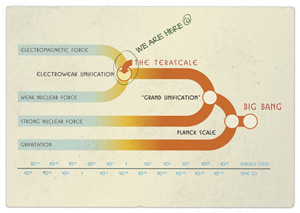Graphics
-
The Mu2e experiment looks for muon particles to change in a different way than previously seen: the breakdown into a more stable electron particle and jettison of the extra mass in the form of energy. When muons stop in aluminum they form atomic systems similar to the way electrons bind to the nucleus in ordinary matter (left). A tiny fraction of the time the bound muon can convert to an electron that is ejected from the aluminum (right). (Credit: symmetry magazine)Click image for larger version
-
A Feynman diagram of the most common muon decay mode. (Credit: Fermilab)Click image for larger version
-
The Intensity Frontier is one of three research frontiers in particle physics. Because muon-to-electron conversion is hypothesized to occur very rarely, scientists increase the chance of observing this conversion by using accelerators to create a beam with a plenitude of muons. (Credit: HEPAP)Click image for larger version
-
 Muon-to-electron conversions are not only difficult to detect, like pulling a needle out of a haystack, but occur vary rarely. It is as if the needle only existed in one out of hundreds of haystacks. Physicists increase the probability of observing the conversion by increasing the number of muons, or haystacks, available for probing. Mu2e will have enough sensitivity to see a muon transform to an electron even if that only occurs in one out of 100 million billion muons. (Credit: Fermilab Education Office)Click image for larger version
Muon-to-electron conversions are not only difficult to detect, like pulling a needle out of a haystack, but occur vary rarely. It is as if the needle only existed in one out of hundreds of haystacks. Physicists increase the probability of observing the conversion by increasing the number of muons, or haystacks, available for probing. Mu2e will have enough sensitivity to see a muon transform to an electron even if that only occurs in one out of 100 million billion muons. (Credit: Fermilab Education Office)Click image for larger version
-
The Mu2e detector is a particle physics detector embedded in a series of superconducting magnets. The magnets are designed to create a low-energy muon beam that can be stopped in the thin aluminum stopping target. They also provide a constant magnetic field in the detector region that allows the momentum of the conversion electrons to be accurately determined. (Credit: Fermilab)Click image for larger version
-
A team of physicists, including postdocs and graduate and undergraduate students have begun assembling a Mu2e test stand at Fermilab. The team will fine-tune a detector prototype using cosmic ray test data. (Credit: Fermilab)Click image for larger version
-
Particle accelerators allow physicists to look farther and farther back in time, to revisit the high energies of the early universe after the Big Bang. Do the four forces we observe today - gravity, the electromagnetic force, and the weak and strong forces - converge to a single unified force at ultra-high energy? The Mu2e experiment may provide the first evidence for such unification of forces. (Credit: symmetry magazine)Click image for larger version
-
The proposed apparatus design for a Mu2e experiment. An 8 billion electronvolt, or 8 GeV, proton beam aimed at an apparatus containing a fixed target would generate a large number of muons to send to a detector so that physicists can track whether the muons change into electrons. (Credit: Mu2e)Click image for larger version
Last modified: 01/05/2012 | email Fermilab


 European Project
European Project








